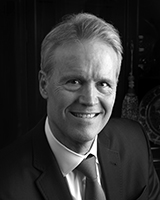
David B. Hellmann,
M.D., M.A.C.P.
You may have noticed that we have a tech theme going with this issue of Breakthrough. It’s not technology for its own sake; we’re not impressed with bells and whistles just because they can do cool things. What we are interested in is helping people – our patients and the people in our community – to live better lives.
One tiny example of this may surprise you: it’s not anything new or fancy, it’s the humble hearing aid. Jeremy Walston, after years of studying people as they get older, has come up with some common-sense things that the healthiest and happiest have in common (see Page 12). If you need a hearing aid, get one: because if you can’t hear what people are saying, you may start to withdraw and isolate yourself, and that hurts your brain. Connecting with others is good medicine.
That theme of caring and reaching out is what our Medicine for the Greater Good initiative is all about (see Page 20). For us here in Baltimore, the recent riots brought home how far we all have to go. In November, our Bayview Internal Medicine Residency Directors wrote in the New England Journal of Medicine that as physicians, we naturally “want to provide outstanding medical services to this vulnerable population” here in our neighborhood. But unless we also address the “intractable sense of hopelessness,” we will not truly succeed.
We continue to do our best to turn out more caring physicians and to honor our finest clinicians. You can read about the “sticking power” of our Good Doctor Initiative on Page 18, and meet one of our newest inductees in the Miller-Coulson Academy of Clinical Excellence on Page 22.
And now, what about all that new technology? Well, it’s pretty exciting stuff. One of our residents, Francoise Marvel, has developed an app to help our patients who have gone home after being hospitalized for a heart attack. Too many of these people – all over the country – end up coming back to the hospital within a month. Just about all of them have a cell phone, and Marvel believes this may be the key to keeping them healthier (see Page 7). Jiande Chen, a scientist in our Amos Food, Body, and Mind Center, has developed a smart watch for acupuncture (see Page 10). It delivers a safe, painless dose of electric current that penetrates as deeply and precisely as an acupuncture needle – but patients can use it in their own homes, right after every meal, to help their stomachs work better. The CIM celebrates innovative thinking, and this blend of Eastern medicine and cutting-edge science offers an exciting new approach that may help treat other problems, as well.
Finally, we come back to where we started, at the patient’s bedside. Handheld ultrasound (see Page 4), a pocket-sized device, lets doctors watch the patient’s heart contract, measure blood blow, check the heart valves, spot an aneurysm and even detect a gallstone. It doesn’t replace the physical exam, it just helps us do it better – so that we can help people better.
I hope you have a wonderful summer,

Aliki Perroti Professor of Medicine;
Vice Dean, Johns Hopkins Bayview Medical Center;
Chairman, Department of Medicine